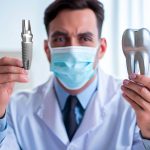Have you truly realized that oral health is about far more than a bright, even smile? It is in fact the “first gateway” to your overall well‑being. Decades of follow‑up research by the World Health Organization (WHO), backed by vast clinical data, have repeatedly confirmed that gum disease is significantly linked to greater difficulty in controlling diabetes and to higher rates of cardiovascular events—and that imbalances in the oral microbiome may even indirectly affect respiratory health. When you wince at a toothache or hide your smile because of missing teeth, you may not notice that oral problems are quietly becoming an “invisible driver” threatening your whole‑body health.
This article, written by seasoned specialists from a top‑tier (Class III) hospital’s Department of Stomatology, systematically reviews the underlying mechanisms and coping strategies for eleven common oral concerns—from periodontal disease prevention to post‑implant care, from the golden window for pediatric orthodontics to denture maintenance in older adults. It also offers practical modules on the principles of dental implants and the daily upkeep of clear aligners, helping you build a comprehensive understanding of oral‑health management—from prevention to treatment.
11 Common Dental Problems You Should Know About (The Definitive Guide to Oral Health 2025)
1. Bad Breath (Halitosis)
Chronic, often‑ignored bad breath is in fact a danger signal of an imbalanced oral environment. Studies show that more than 85 % of persistent halitosis originates inside the mouth. The three main causes are (1) inflammatory exudate from gingivitis, (2) volatile sulfur compounds (VSCs) produced by anaerobic bacteria in deep periodontal pockets, and (3) shed epithelial cells and food debris accumulating on the tongue coating. Many patients think masking the odor is enough, yet alcohol‑based mouthwashes can disrupt the oral microbiome, and the residual sugar in mint candies actually fuels bacterial growth—creating a “the more you cover, the worse it smells” vicious cycle.
Three‑step scientific response:
- Basic defense layer: Use a soft‑bristled toothbrush to gently clean the dorsum of the tongue daily (especially the posterior third) and floss or use an oral irrigator to remove food debris between teeth, cutting off bacteria’s “food supply.”
- Deep‑clean layer: Undergo professional ultrasonic scaling every 6–12 months to remove supragingival and shallow subgingival calculus, preventing calculus from compressing the gums and triggering inflammation.
- Targeted treatment layer: If halitosis is accompanied by gum bleeding or tooth mobility, periodontal probing and X‑ray evaluation are necessary to assess periodontal destruction; subgingival curettage and local medication may be required as part of a systematic periodontal intervention. In the rare cases where halitosis stems from non‑oral factors such as sinusitis or gastroesophageal reflux, multidisciplinary treatment is needed.
Special reminder:
• Wearers of removable dentures should soak‑clean them daily to keep them from becoming “petri dishes” for bacteria.
• Smokers should increase the frequency of periodontal check‑ups: tar in tobacco accelerates plaque buildup and reduces gingival blood flow, sharply raising the risk of bad breath.
2. Tooth Decay (Cavities)
While you savor the fluffy texture of cake or the sweetness of milk tea, Streptococcus mutans in your mouth is launching an “acid assault.” These bacteria metabolize sugars into organic acids, creating an acidic micro‑environment (pH can plummet below 4.5) that lasts 2–3 hours and dissolves the hydroxyapatite crystals in enamel. As a chalky white spot progresses into a dark crater reaching dentin, bacteria and their toxins may invade the pulp, causing severe pain—or even jawbone infection.
Three Misconceptions to Avoid
- “Baby‑tooth cavities don’t need treatment.” Caries in primary teeth can disturb the development of permanent tooth buds, leading to hypomineralized enamel.
- “Implants can’t get cavities.” Although titanium itself doesn’t decay, caries on adjacent teeth can spread via periodontal pockets and trigger peri‑implant mucositis.
- “Painless cavities can be ignored.” Deep caries may approach the pulp long before pain starts; a simple filling now can prevent costly root‑canal therapy and increased tooth fragility later.
Whole‑Life Protection Strategy
① Daily Defense System
- Fluoride reinforcement: Brush with fluoride toothpaste (1,000–1,500 ppm). Parents should supervise dosage—grain‑of‑rice size for children under 3; pea size for ages 3–6.
- Sugar control: Keep free‑sugar intake below 5 % of total daily energy (WHO guideline); watch out for “hidden sugars” in juices and honey.
- Saliva utilization: Chew sugar‑free gum (with xylitol) to boost saliva, whose buffering capacity neutralizes acids while IgA impedes bacterial adhesion.
② Targeted Interventions
- Fissure sealing: Apply resin sealant to the deep pits and fissures of first molars (ages 6–7) and second molars (ages 11–13) to prevent occlusal caries.
- Early‑caries monitoring: Use laser fluorescence (DIAGNOdent) or digital bite‑wing radiographs to detect hidden lesions invisible to the naked eye.
- Micro‑invasive restoration: Treat early enamel caries with resin infiltration (Icon), avoiding the tooth reduction of traditional drilling.
③ Special Care for Implants
- Spatial cleaning: Use a single‑tuft brush daily around implant abutments; employ an interdental brush (≤ 1.2 mm diameter) to clean under bridgework.
- Scheduled maintenance: Have peri‑implant probing every six months; if bleeding on probing exceeds 25 %, apply local chlorhexidine gel therapy.
- Occlusal management: Avoid biting hard items (nuts, crab shells) to prevent stress concentration at the implant neck and subsequent bone resorption.
Special Note: Women planning pregnancy should complete cavity treatments in advance; hormonal shifts during gestation can triple the progression rate of existing lesions. For orthodontic patients, brackets create “plaque retention zones.” Use orthodontic toothbrushes with 0.05 % NaF mouth‑rinse for combined protection.
3. Gum Disease (Periodontal Disease)
If you see bleeding while brushing or find bloodstains on an apple after biting, your mouth is sending a red alert. Gum disease follows a progressive path of inflammation → tissue destruction → tooth loss, and its impact extends far beyond oral discomfort. Studies show that patients with severe periodontitis face a 19% higher risk of cardiovascular events, and periodontal pathogens are detected three times more frequently in the cerebrospinal fluid of Alzheimer’s patients compared to healthy individuals.
Disease Stages & Clinical Features
| Stage | Pathology | Symptoms | Reversibility |
|---|---|---|---|
| Gingivitis | Plaque accumulation causes gingival capillary dilation; affects only marginal and interdental gingiva | Red, swollen gums, bleeding on probing (BOP+), worsened breath | Fully reversible |
| Early Periodontitis | Inflammation breaches junctional epithelium; shallow pockets (4–6 mm), mild bone loss | Slight tooth mobility (Grade I), chewing weakness, cold sensitivity | Partially reversible |
| Advanced Periodontitis | Extensive ligament destruction; deep pockets (≥6 mm), >½ root-length bone loss | Tooth shifting, flaring, pus discharge, mobility Grade II–III | Irreversible |
Periodontal Health: A Hidden Threshold for Implants
For patients considering dental implants, periodontal status directly affects both surgical success and long-term outcomes:
- Bone volume crisis: Untreated periodontitis causes horizontal bone loss, limiting implant depth and increasing risk of exposure.
- Infection risk: Pathogens like Aggregatibacter actinomycetemcomitans (Aa) and Porphyromonas gingivalis (Pg) in periodontal pockets can spread and trigger peri-implantitis.
- Occlusal mismatch: Tooth shifting from periodontal damage alters bite force distribution; without orthodontic correction or occlusal adjustment, implants may face lateral forces that accelerate bone resorption.
Ideal Conditions for Implant Candidacy
- Probing depth (PD) ≤ 4 mm with no bleeding
- Clinical attachment loss (CAL) ≤ 2 mm
- Interdental bone loss < ⅓ root length
- Stable systemic conditions (e.g., HbA1c < 7% for diabetics)
Four-Step Scientific Prevention Plan
① Plaque Control
- Use the modified Bass technique (45° vibration at the gum line) twice daily, 2+ minutes each session
- Incorporate an irrigator with 0.06% chlorhexidine, especially for molars and implant areas
② Inflammation Management
- Gingivitis: Supragingival scaling + topical iodine glycerin (once daily for 5 days)
- Periodontitis: Subgingival curettage + root planing (SRP); may combine with laser-assisted therapy
③ Bone Regeneration (if needed)
- For insufficient bone volume, consider guided bone regeneration (GBR) or sinus lift surgery to ensure implant support
④ Lifetime Maintenance
- In the first year post-implant, schedule checkups every 3 months; then switch to 6-month intervals
- Avoid smoking (implant failure rate triples for smokers) and address bruxism (teeth grinding)
Special Alerts
- For denture wearers: If you develop denture-induced stomatitis (pain, swelling), stop wearing the denture and disinfect it. Chronic irritation may speed up alveolar bone resorption, affecting future implant stability.
- For peri-implantitis cases: A combined protocol of debridement + localized antibiotic release + laser disinfection can help achieve optimal maintenance targets:
- >80% plaque control rate
- <20% bleeding on probing
Gum disease is both treatable and preventable. Early awareness, regular checkups, and professional intervention are key to protecting your natural teeth—and securing your success with implants.
4. Oral Cancer
Every ten minutes, one person dies of oral cancer worldwide. Its 5‑year survival rate is only 65 %, far lower than that of breast cancer (90 %) or prostate cancer (99 %). Early detection is the key: Stage I oral‑cancer patients have an 83 % 5‑year survival rate, but this plummets to 32 % at Stage IV.
High‑Risk Factors & Screening Strategy
| Risk Tier | Causative Factors | Screening Recommendation |
|---|---|---|
| Tier 1 | Smoking + alcohol (synergistic risk ↑ 15×); HPV‑16/18 infection (strongly linked to oropharyngeal cancer) | Annual professional oral exam for everyone ≥ 40 yrs; every 6 months for high‑risk groups (e.g., habitual betel‑nut chewers) |
| Tier 2 | Chronic trauma (sharp roots/crowns, faulty restorations), excessive sun exposure (lip cancer), immunosuppression | Monthly self‑exams focusing on hidden sites (lateral tongue, floor of mouth, soft palate) |
| Tier 3 | Hereditary oral‑cancer syndromes (e.g., Fanconi‑anemia variant), long‑standing leukoplakia/erythroplakia | Seek dental care within 2 weeks of spotting a suspicious lesion; toluidine‑blue staining or brush biopsy if needed |
Dentist’s “3‑Check, 3‑Ask” Protocol
- Check: Use VELscope fluorescence to detect abnormal vascular patterns.
- Palpate: Bimanual palpation to feel deep masses.
- Ask: “Have you had numbness, pain, or bleeding that has worsened for > 3 months?”
5. Mouth Ulcers & Mucosal Problems
Recurrent aphthous ulcers (RAU) are self‑limiting, yet frequent episodes may signal immune disorders (e.g., Behçet’s) or nutrient deficiencies (iron, B‑12, folate). During implant or orthodontic therapy, mucosal breaks deserve extra vigilance:
- Peri‑implant mucositis risk: Ulcer‑induced dysbiosis may spread hematogenously to implant collars, provoking bone loss.
- Orthodontic traumatic ulcers: Bracket edges abrade mucosa; bacteria invade, causing secondary infection.
Graded Management
| Ulcer Type | Features | Home Care | When to Seek Treatment |
|---|---|---|---|
| Mild RAU | < 5 mm; heals in 1–2 weeks | Apply 0.1 % triamcinolone oral paste 3×/day | > 3 outbreaks/month or diameter > 1 cm |
| Herpetic stomatitis | Clusters of vesicles ± fever/lymphadenopathy | Oral acyclovir 200 mg 5×/day | IV ganciclovir for immunocompromised patients |
| Traumatic ulcer | Shape matches irritant; marked pain | Cover sharp edge with orthodontic wax | Not healed in 2 weeks or indurated base (rule out malignancy) |
Special Tips for Orthodontic Patients
- Choose low‑friction ceramic or self‑ligating brackets to reduce trauma.
- Apply 0.12 % chlorhexidine gel around mini‑screws (TADs) to prevent infection.
- Wear a silicone night‑guard to cushion bruxism‑related pressure.
6. Tooth Erosion
When enamel is exposed to pH < 5.5, mineral loss outpaces remineralization, leading to “acid‑erosion plus wear” damage. Orthodontic appliances raise the risk 2.3 × because they trap plaque and acids.
Acid Attack Pathways
- Exogenous: Soft drinks (pH 2.5), sports drinks (pH 3.2), citrus fruit (pH 2.0‑3.0)
- Endogenous: Gastro‑oesophageal reflux (salivary pH can drop to 4.0), hyperemesis gravidarum
- Iatrogenic: Some mouthwashes with citric acid, whitening products releasing peroxides
Erosion Progress (Visible Signs)
- Early: Chalky white spots (inter‑prismatic dissolution under microscope)
- Middle: Incisal translucency, dentin hypersensitivity (thermal pain)
- Late: “Sand‑paper” roughness, cupping of occlusal surfaces forming erosion craters
Protection Guide for Orthodontic Patients
① Diet Management
- Avoid the “acid snack + immediate brushing” mistake (brushing right after acid exposure accelerates wear).
- Chew sugar‑free xylitol gum after acidic drinks to boost saliva and neutralize acids.
② Appliance Maintenance
- Fixed braces: Use a water flosser (pulse ≤ 90 psi) around brackets.
- Clear aligners: Soak daily in denture‑cleaning tablets for 30 min to remove protein deposits.
③ Professional Care
- Mild erosion: Apply silver diamine fluoride (Ag(NH₃)₂F) to seal dentinal tubules.
- Severe erosion: Restore with veneers or full crowns to regain function and aesthetics.
7. Tooth Sensitivity
When dentinal tubules (1–3 µm in diameter) are exposed, external stimuli—thermal, mechanical, or chemical—trigger “hydrodynamic pain” at the pulp nerve endings. Sensitivity peaks during implant or orthodontic therapy:
- Post‑implant sensitivity: In about 18 % of cases, neighboring teeth react to surgical trauma or graft materials with cold sensitivity lasting 1–2 weeks.
- TAD (mini‑screw) sensitivity: Edematous mucosa or periodontal‑ligament pressure around the screw can cause bite pain that usually subsides in 3–5 days.
| Severity | Triggers | Home Care | Clinical Treatment |
|---|---|---|---|
| Mild | Cold air / lukewarm water (subsides < 10 s) | Toothpaste with 5 % potassium nitrate (e.g., Sensodyne Repair) | 2 % sodium‑fluoride varnish to seal tubules |
| Moderate | Chewing hard food / sweets (lasts minutes) | Avoid triggers; chew sugar‑free gum to boost saliva | Laser desensitization (Er:YAG, 100 mJ/pulse) |
| Severe | Spontaneous dull ache (disturbs sleep) | NSAID such as ibuprofen 400 mg | Root‑canal therapy or pulp‑otomy (in young permanent teeth) |
Notes for Implant Patients
- Avoid electric‑toothbrush contact on adjacent teeth for two weeks post‑surgery.
- Sensitivity persisting > 2 weeks warrants peri‑implant mucositis screening (BOP > 25 %).
8. Toothache & Dental Emergencies
Successful emergency care hinges on acting within 30 minutes for avulsed teeth, fracture fragment storage, and abscess drainage to maximize tissue preservation and infection control.
Scene‑by‑Scene Quick Guide
- Avulsed Tooth
- Storage media (best → acceptable): Hank’s Balanced Salt Solution > cold milk (4 °C) > saline > buccal saliva.
- Do NOT:
- Wrap tooth dry in tissue (PDL cells die in 15 min).
- Scrape root surface (removes viable PDL cells).
- Dislodged Implant
- Immediate care: Compress bleeding site gently with sterile gauze; minimize speaking/swallowing.
- Risk alert: Visible black threads at implant neck suggest > 60 % osseointegration failure risk.
- Loose Orthodontic Mini‑screw
- Mucosal protection: Cover sharp edges with ortho wax.
- Clinic prep: Note time, pain, or bleeding to determine re‑insertion need.
- Acute Periapical Abscess
- Home first‑aid: Cold compress (20 min) + amoxicillin 500 mg TID + metronidazole 400 mg TID.
- In clinic: Pulp access, drainage, and camphorated phenol dressing under local anaesthesia.
9. Unattractive Smile — Precision Aesthetic Dentistry
Modern esthetic dentistry balances function, esthetics, and biocompatibility via digital workflows (intra‑oral scan + CBCT).
| Procedure | Best for | Pros | Limitations |
|---|---|---|---|
| In‑office light whitening | Extrinsic stains, mild fluorosis | 5–8 shade jump in one visit; lasts 1–2 yrs | Temporary sensitivity (~35 %) |
| Porcelain veneer | < ⅓ tooth loss, ≤ 2 mm diastema | Minimal prep (0.3–0.5 mm); excellent biocompatibility | Relatively costly (CNY 3k–8k per unit) |
| All‑ceramic crown | Severe tetracycline stains, fractured teeth | High strength (1,200 MPa); natural translucency | More tooth reduction (1.5–2 mm) |
| Implant restoration | Single / multiple missing teeth, edentulous | 90 % of natural chewing efficiency; prevents drifting | Longer course (3–6 mo); higher cost |
| Orthodontic TADs | Severe skeletal malocclusion needing absolute anchorage | Precise tooth movement (< 0.1 mm error) | Strict asepsis; < 5 % bone‑loss risk |
Multidisciplinary Case — Skeletal Class II Aesthetic Correction
- Chief complaint: 25‑year‑old female, maxillary protrusion + gummy smile.
- Plan:
- Ortho: Four mini‑screws (mesial to UL/UR 6s) + J‑hooks for anterior intrusion.
- Restorative: Gingivoplasty to harmonize smile line; IPS e.max crowns for #11/#21 defects.
- Retention: Vacuum‑formed retainer + myofunctional therapy.
Key checkpoints
- Implant restorations: CBCT bone‑density > 850 HU.
- TAD placement: ≥ 2 mm from sinus floor; ≥ 1.5 mm from IAN canal.
10. Root Infection & Root‑Canal Therapy
When pulp infection breaches the apical foramen (≈ 0.1–0.3 mm), bacteria and toxins trigger a destructive cascade—periapical granuloma → abscess → cyst—ultimately causing jaw‑bone resorption (each week’s delay enlarges the lesion by 0.5–1 mm).
Four‑Stage Precision Protocol
| Stage | Key Steps | Technical Points | Risk Control |
|---|---|---|---|
| Diagnosis | CBCT (≤ 0.08 mm voxel) to map canal anomalies (MB2 incidence > 70 %) | Compare pre‑/post‑op images; ≥ 30 % shrinkage of radiolucency = success | Exclude adjacent‑tooth lesions (misdiagnosis up to 15 %) |
| Access | Ultrasonic tip ET20D to remove roof precisely and avoid perforation | Maintain original canal anatomy; don’t miss lateral canals (20–40 % incidence) | Use rubber dam—gold standard for infection control |
| Disinfection | 5.25 % NaOCl (37 °C) + 17 % EDTA gel to dissolve smear layer | Ultrasonic agitation 30 s × 3 to drive irrigant to apical third | Prevent NaOCl extrusion that can chemically burn mucosa |
| Obturation | Warm vertical compaction (System B + Obtura III); apical seal flush (≤ 0.5 mm overfill) | For cold lateral condensation, match accessory cones (–0.05 mm taper) | Re‑check occlusion in 1 week to avoid over‑high filling → root fracture |
If Root‑Canal Therapy Fails—Implant Decision Tree
- Infection clearance
- Success: symptom‑free + CBCT shows lesion resolved + probing ≤ 3 mm.
- Failure: residual cyst (> 5 mm) → apicoectomy under microscope + retrograde fill.
- Timing of Implant Placement
- Acute infection: delay 3–6 months for bone healing.
- Chronic infection: simultaneous guided bone regeneration (GBR) possible; cover with collagen membrane (e.g., Bio‑Gide).
- Implant Selection
- Prefer bone‑level implants with platform switching in infection history cases.
- Avoid trans‑gingival healing abutments directly in the infected zone (2.3 × higher risk).
11. Bruxism
Night‑time bruxing can generate forces six times normal chewing load (peaks > 1,000 N). The accumulated micro‑trauma threatens implants, orthodontic hardware, and natural teeth:
- Implants: micro‑crack propagation at the osseointegration interface (fatigue life ↓ 40 %).
- TADs: surrounding bone resorption (probing depth + 1.5 mm).
- Natural teeth: exposed dentin (sensitivity risk × 3).
| Severity | Clinical Signs | Night‑EMG Data | Intervention |
|---|---|---|---|
| Mild | < 3 episodes/month; < 0.5 mm wear | Peak EMG < 50 µV | Custom soft splint (2 mm) |
| Moderate | > 2 episodes/week; AM TMJ soreness | EMG 50–100 µV for > 20 min | Hard splint (3 mm) + botulinum toxin 50 U per side |
| Severe | Daily bruxing; tooth fracture or implant mobility | EMG > 100 µV ± apnea events | Occlusal adjustment + full polysomnography |
Special Care for Implant / Orthodontic Cases
- Implants: splint must cover crown with 100 µm relief to prevent overload.
- TADs: inject 1 ml hyaluronic acid around screws to create a protective cushion.
- Active orthodontics: use low‑friction NiTi round wires to disperse stress.
Multidisciplinary Case — Bruxism + Apical Infection with Implant Failure
| Pre‑treatment | Post‑treatment | |
|---|---|---|
| ISQ (implant stability) | 58 | 72 (6 mo) |
| EMG peak | 120 µV | 45 µV (12 mo) |
| Bruxism frequency | nightly | 1×/week |
Key Steps
- Debridement + slow‑release chlorhexidine chips (14 days).
- Er:YAG laser (50 mJ/pulse) for peri‑implant detox.
- Hard splint with pressure sensors + monthly botulinum toxin injections.
- Replace with wide‑diameter (Ø 5.0 mm) implant via dynamic navigation, dodging sinus and IAN.
Return on Investment in Oral Health
- Prevention: brushing twice + flossing once daily cuts caries risk by 40 %.
- Early treatment: root‑canal success (92 %) surpasses 5‑year implant survival (85 %).
- Longevity: comprehensive maintenance can extend implant life to 20+ years (global mean 15).
Action Points
- Book a bruxism risk assessment (including EMG).
- Apply “treat‑restore‑maintain” protocol to root‑treated teeth.
- Implant / ortho patients: dynamic occlusal analysis every 6 months.
Through graded management, interdisciplinary teamwork, and precision technology, we can rescue at‑risk teeth and provide patients with long‑term functional and aesthetic balance.
References:
World Health Organization (WHO) – Oral Health Report
American Dental Association (ADA) – Guidelines on Common Oral Diseases
Chinese Stomatological Association – Clinical Protocols and Expert Consensus in Dentistry
International Team for Implantology (ITI) – Consensus Reports
American Association of Orthodontists (AAO) – Clinical Guidelines
Medical Disclaimer:
This article is intended for educational purposes only, aiming to enhance public awareness of oral health and common dental issues, including foundational knowledge of dental implants and the application of orthodontic mini-implants (TADs). All information provided herein does not substitute for a professional dental consultation or individualized treatment plan. If you experience any oral discomfort or have specific health concerns, please seek timely diagnosis and care from a licensed dental professional at a certified medical institution.





